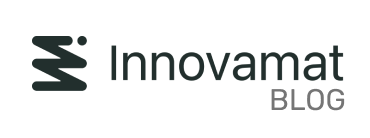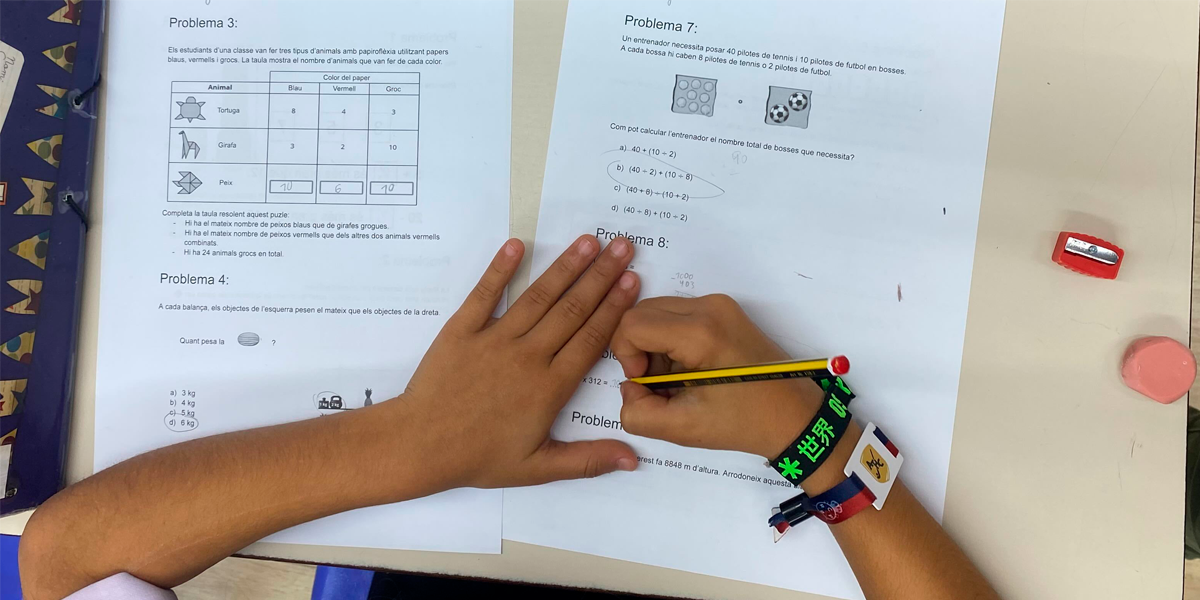In Neus Sanmartí’s (2009) more than recommendable work on assessment, the author argues that one of the aspects that should be reviewed first are the activities set to assess the level of acquisition of competencies and that, if we continue to assess through traditional written tests with mainly reproductive questions, nothing will have changed.
For any teacher who has worked long enough in a classroom with 6- or 7-year-old students, this insight will be even more apparent, since the degree of language proficiency acquisition at that age greatly limits the ability to communicate, argue, or explain a resolution strategy in writing. So, beyond the traditional written tests, how can we obtain evidence to assess competency?
Assessing processes with well-rounded activities
The key lies in mastering the competency framework (i.e., knowing what processes we are working on and what we expect from our students) and to pay attention, for example, to their visual or graphic representations, or to their interventions during classroom conversation, especially at early ages.
In this vein, we have selected some of the well-rounded activities from Innovamat’s curriculum that we consider particularly suitable for assessment using this media. These activities are not the only ones suitable for carrying out assessment, but they provide advice and guidance on how to assess any other well-rounded activity that we as teachers consider appropriate.
Let’s see it through a concrete example, the real case of some 1st grade students who did an activity on measurement. This involved measuring the length of some objects represented in the logbook using three different units of measurement: fingers, cubes and a third unit of their choice.

What can we assess in an activity like this? To begin with, resultative counting from 1 to 20 and the writing of these numbers, which is such necessary content that, if they are not mastered, the whole activity is affected.
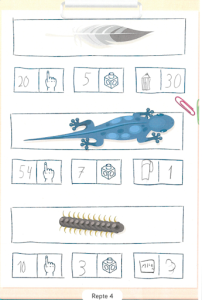
In this case, we observed some answers with excessive numbers, such as “30 pencils” or “54 fingers”. It is possible that this student’s problem has to do with number sense, rather than measurement.
We can ask how these numbers are read, and whether they are larger or smaller than other reference numbers.
In addition, it is clear that students will have to bring into play some specific knowledge of the meaning of measurement. For example,
- Do you use an accurate measurement technique when measuring with your fingers?
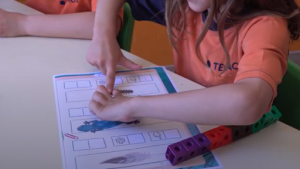
In this case, the student touches the index fingers of either hand, placed perpendicularly to the object, which allows them to be consistent and always obtain the same measurement.
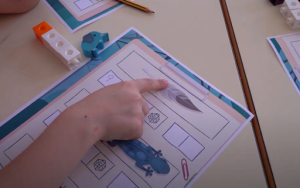
In contrast, in this case the student uses only one index finger to ‘jump’ along the object. In doing so, they lose the reference of the exact point at which they had measured and, when repositioning the finger, leave gaps or remeasures a space already measured.
We can point out that this technique is not very accurate and may result in a different result when measuring again, even if you use the same finger and the same technique.
We can ask them: “How can you be sure that when you lift your finger and put it back down, you haven’t put it in the same place as before?”.
Let’s carry on! Of the different tasks implicit in this activity, clearly the most competency-based is the one that has to do with judiciously choosing the unit of measurement. We can consider:
- Does the student make sure to choose an object that is always the same length as the unit of measurement?
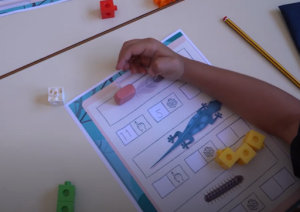
Here, the student uses an eraser without changing its orientation.
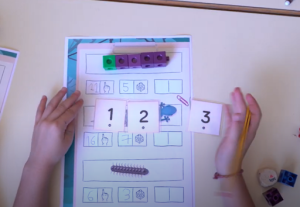
Here, on the other hand, they measure with laminated number cards. At times, they measure against the plastic thickness and at others, measures only against the white part of the card, leaving out the plastic margin.
We can show the student the incongruity if we ask them to measure the same object again and ask if they obtained the same result.
On the other hand, this activity requires some mathematical process skills. In terms of Problem Solving, we could suggest:
- When asked to choose a unit of measurement, do they find an optimal solution?
In this case, it is interesting to note that the concept of ‘optimal’ can be nuanced according to the student’s criteria. What were they aiming for: to be accurate or to be efficient? Or both?
Let’s look at a couple of different examples:
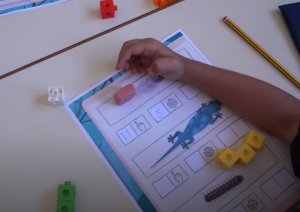
This student has chosen an eraser. In doing so, they have been able to be accurate (referring only to the element and not the technique, which will also affect the degree of accuracy), since the unit of measurement fits several times in the length of the measured object. Also, they registered ‘4 and a half’ in their logbook.
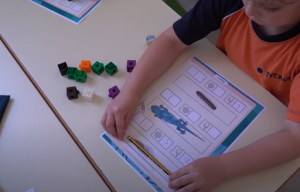
This student, on the other hand, selected a pencil, which allowed him to be more efficient: he only needed one measurement to give the answer.
In both cases, it would be pertinent to ask them what criteria they have followed and how they would go about considering a different criterion.
This is also related to Problem Solving. We can ask:
- Do you check that the solution you have obtained is reasonable?
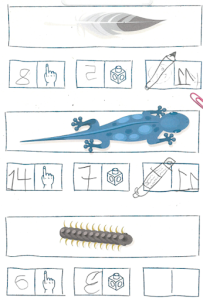
Without assessing the accuracy of the measures taken, we can observe that the answers are reasonable in terms of the relationship between them.
The responses expressed in fingers and cubes are consistent with the fact that, at a glance, the lizard is the longest element, and the centipede the shortest.
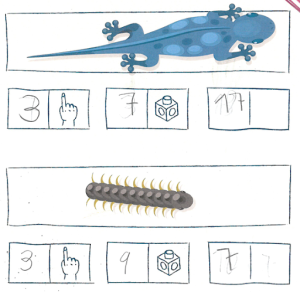
In this case, it is not reasonable that two illustrations that, to the naked eye, have clearly different lengths measure the same (3 fingers). The answer becomes even more illogical when we see that the lengths measured with cubes are different.
It would be interesting to make this evident by asking questions and guiding the student to consider the importance of reviewing the results.
Finally, we could ask some questions to diagnose the degree of acquisition of the Reasoning and Proof process:
- Is the student able to justify why they measure in a particular way?
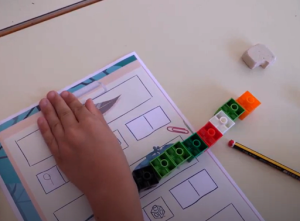
This student, when measuring with their fingers, uses all 5 at the same time. We can ask them why they do this.
They might not know how to justify it or, on the contrary, they might reason that, this way, they will measure faster.
And one last one related to Reasoning and Proof:
- Does the student observe that the measurement with cubes is more reliable than with fingers?
As we said at the beginning, asking a 6 or 7 year old student to write down a reasoning may not be the best way to assess processes. For this reason, we must take into account the possibility of also assessing the conversations that are generated in the classroom:
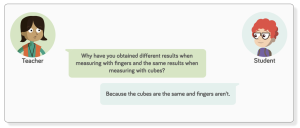
Another great potential of classroom conversation is that, should a student respond in a less than explicit way, the teacher can manage the conversation on the spot to find out more clearly what the student is actually reasoning.
Assessment at Innovamat
At Innovamat we believe that the main function of assessment is its formative aspect; that is to say, it should allow students to regulate their own learning process. In this sense, something that will clearly help our students is sharing comments with them such as the ones we have been detailing throughout this article. If we do, we will have assessed them, not graded them.
At the same time, if what we want is to use this task to grade the results of the learning process (give grades), we could use the different questions that we have been describing as assessment indicators and, if we consider it appropriate, analyze them.
As we have seen, knowing what we can observe in each moment and having some examples to hand of real student responses are resources that can help us a lot in the difficult task of assessment.
- NCTM (2000): Principles and Standards for School Mathematics. Reston, VA, United States
- Sanmartí, N. (2020) Avaluar és aprendre: Assessment to improve student learning within the framework of the competency-based curriculum. General Directorate of Curriculum and Personalization. Department of Education. Barcelona, Spain
